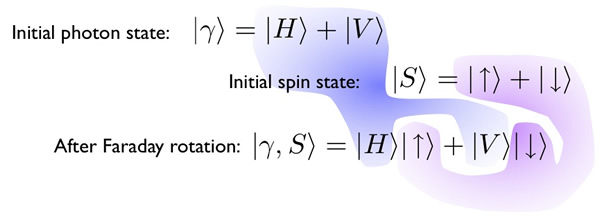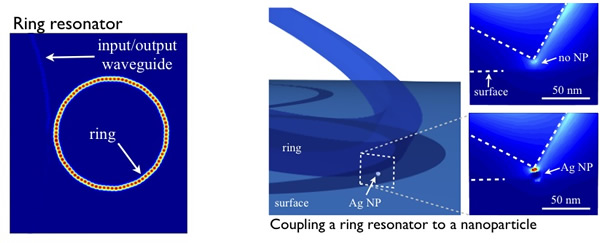Probing spins with single photons
Generating spin-photon entanglement via Faraday rotation
When a linearly polarized photon interacts with an electron spin, the Faraday effect results in a rotation of the photon's polarization. For example, take an initially vertically polarized photon that interacts with an electron spin that is either in the "spin up" or "spin down" state. (The basis for the spin states is defined by the photon propagation direction.) If the electron is in the "spin up" state, then the photon polarization will be rotated in one direction, and if the electron is in the "spin down" state, the photon polarization will be rotated in the opposite direction.
If the spin and photon are in a superposition of their basis states, the Faraday effect can be used to generate an entangled state (ref). To illustrate this, consider a strong spin-photon interaction that rotates the photon polarization by +/- 45 degrees. Consider a photon initially polarized at 45 degrees, that is, in an equal superposition of the basis states, as shown in Fig. 1. If the spin is in the "spin up" or "spin down" state, then the photon will wind up in one of the two eigenstates. But if the electron is in a superposition of "up" and "down," then the final state of the spin-photon system will be entangled -- the state could be described as [(photon horizontal, spin up) AND (photon vertical, spin down)].
 |
| Fig. 1: Entangled spin-photon state generated by Faraday rotation interaction. |
In realistic systems, the angle through which the Faraday effect rotates polarization is quite small. For a small rotation angle, the degree of entanglement would be less than the ideal case shown in Fig. 1. Our research aims to detect and characterize this entanglement, and to find ways to enhance it.
Probing spin-photon interactions with photon statistics
 |
| Fig. 2: Schematic setup for probing electron spins with photon statistics. |
To measure the quantum interaction between a photon and electron spins, one must treat both the spins and the photons as quantum systems. (It is often the case that the light is thought of as classical field.) This leads us to borrow techniques from quantum optics, and use them to probe electron spins in the solid state.
Figure 2 shows a schematic experiment to use photon counting statistics to probe the state of one or more electron spins. The sample here could be an ensemble of spins in a semiconductor, or a single spin confined to a quantum dot. The sample may be placed in an optical caivty to enhance the spin-photon interaction. First, a pump pulse is incident on the sample, and serves to initialize the spin state. Linearly polarized probe photons are also incident on the sample, attenuated such that there is a low average photon flux (say, 1 photon / nanosecond). After the sample, the probe photons will pass through a polarizing beamsplitter and will be sent to one of two single photon detectors.
By analyzing statistics of the time elapsed between the arrival of a pump pulse and a photon at detector A or B, we can extract information about the spin state as a function of time.
Enhancing spin-photon interactions with engineered photonic environments
 |
| Fig. 3. The local photonic environment may be controlled by positioning an optical resonator near a nanostructure of interest. |